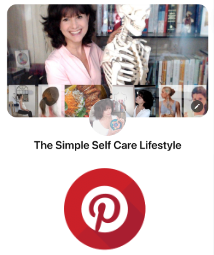Anxiety can cause many uncomfortable and sometimes scary symptoms, such as shortness of breath, inability to control your emotions, or the feeling that you cannot move as well as:
- chest pain,
- sweating,
- a pounding heart,
- the feeling that you can’t breathe,
- a lump in your throat,
- nausea,
- diarrhea (irritable bowel),
- general irritability,
- fatigue,
- a looming sense of fear,
- the inability to wind down to sleep, and so much more…
As with Nighttime Leg Cramps, Indigestion, Fat Loss, ED, Incontinence, AB Separation, or any Common Condition, knowing what is going on in our body is the key to finding the Self Care Actions that help to resolve them.
When it comes to Anxiety, here’s how we will figure out what may work:
- First, we’ll walk through: What Creates Anxiety Symptoms?
- Then: 8 Common Triggers that Can Promote Anxiety.
The Next Post Will Share Tips/Tools that can:
- Lower Anxiety Quickly.
- And Have Focused Actions that help Prevent Anxiety.
This 2-post series came from the below email:
Q: mo, What causes the way I feel when I have my anxiety symptoms? Are there things I can do when in anxiety and also to prevent it?

A: What great questions. A very Simplified Answer- Anxiety symptoms come from
- Messaging between 3 brain regions that flood hormones and chemicals in the nervous system.
- The Nervous System signals ALL our other Systems to gear up for Fight, Flight, or Freeze.
- Our Amped Up Systems create the Symptoms that make us uncomfortable, like increased heart rate, feeling you can’t breathe, and inability to think, etc., and the uncomfortable symptoms can prompt a bigger sense of fear and anxiety about what is happening in your body, feeding, and escalating the anxiety loop.
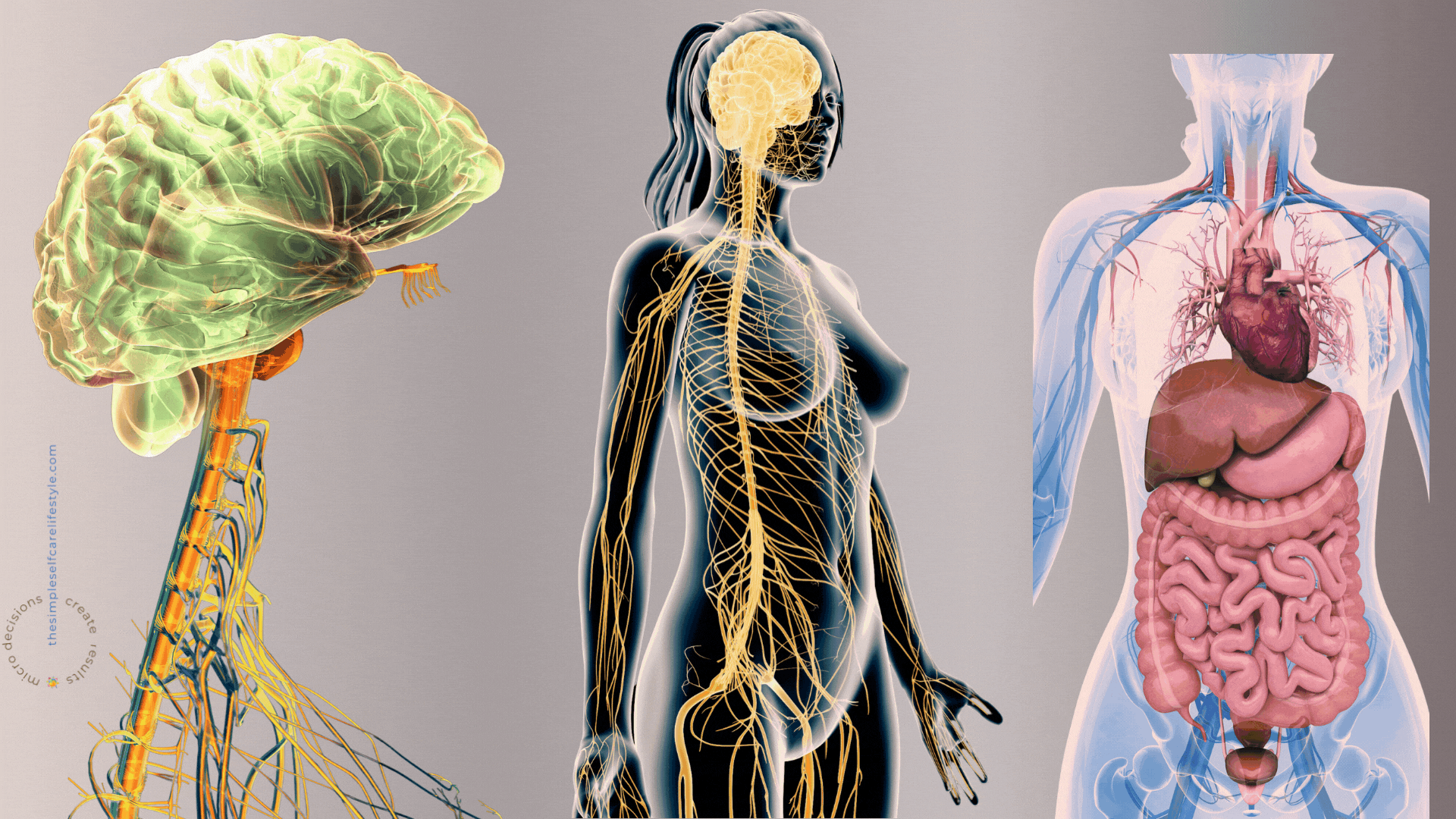
It can be very helpful to know this simplified description because knowing what is going on can help:
- reduce the fear that NOT knowing what is going on can create.
- identify possible triggers so you can more effectively
- leverage the way the body works to help reduce your anxiety as quickly as possible, and
- implement focused actions that, over time, can prevent the symptoms.
Let’s do a quick visual overview of the 3 areas of the brain and their roles in anxiety.
The 3 Areas Of the Brain

Anxiety – 3 Areas of the Brain to know about
Messaging Between 3 areas of the Brain.
Area 1: The Brain Stem
The Brain Stem is responsible for our VITAL bodily functions like: (1)
- Breathing
- Consciousness,
- Blood pressure,
- Heart rate, even Chest Pain.
- Digestion issues. (2)
- Sleep…

The Brain Stem is KEY to the symptoms we experience because it controls our Involuntary Systems.
It is where our uncomfortable anxiety symptoms stem from. Examples include:
- pounding heart,
- the feeling that you can’t breathe,
- lump in your throat,
- nausea,
- diarrhea (irritable bowel),
- general irritability,
- fatigue,
- a looming sense of fear,
- chest pain,
- sweating,
- inability to wind down to sleep and, and, and…
When the Brain Stem receives messaging from the Emotions Center #2 (Limbic System) that there is something to worry about, its response is to prepare the body to Fight, Flee, or Freeze.
Area 2 The Emotions Area
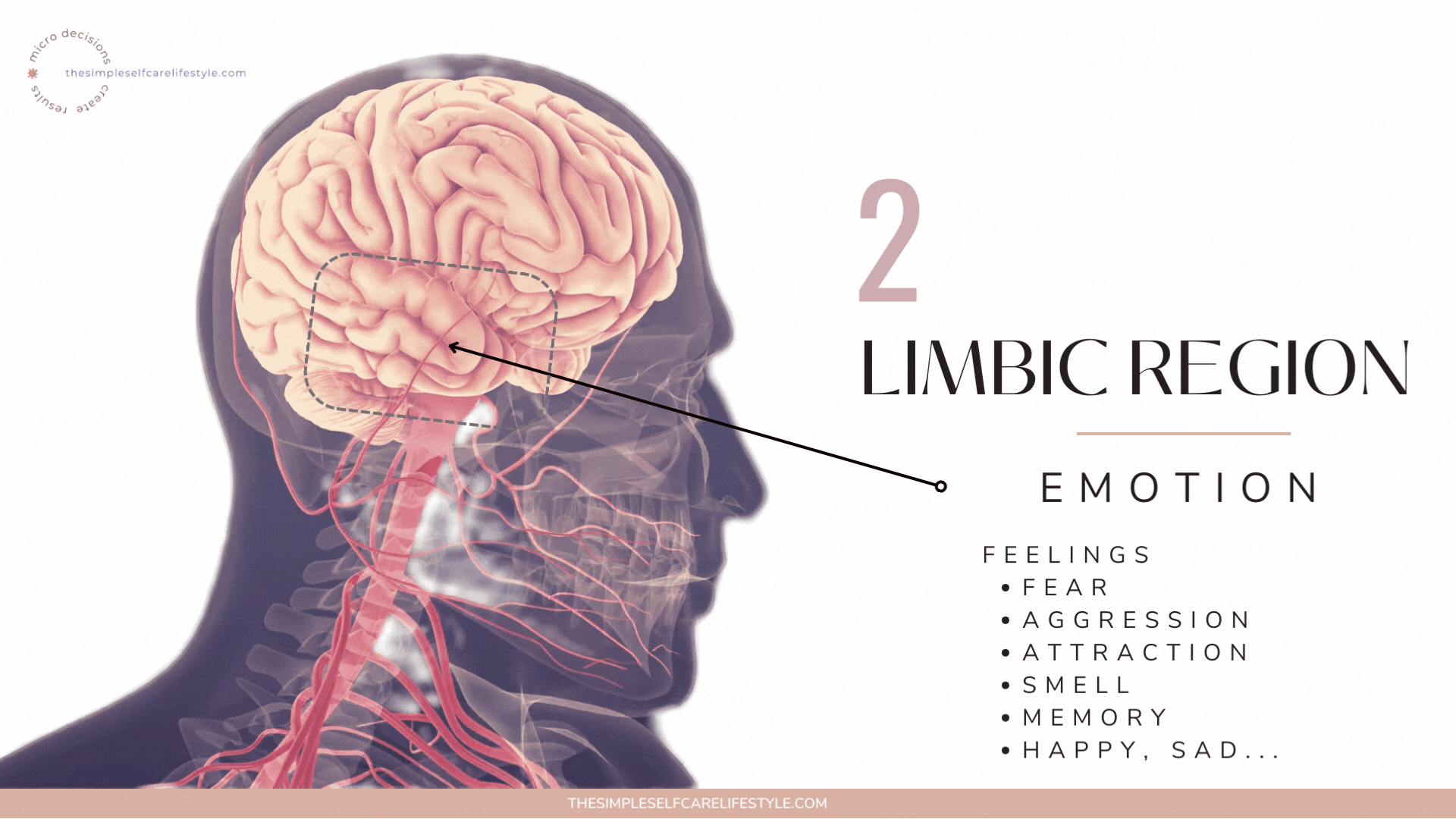
The Limbic Area #2 is where our Emotions process. Our feelings of:
- Fear
- Aggression
- Attraction
- Smell
- Memory
- Happy, Sad, Apprehension Feelings…
When the Emotions Area #2 is sending messaging to the Survival Area (Brain Stem #1) via hormones/chemicals, your body shifts physiology in such a way that you can be faster, stronger, and/or better able to freeze in place– if being motionless will help you survive.
Why do we feel anxiety in different parts of our body?
The answer is that the Brain stem is connected to your entire Nervous system. Your Nervous System directs all your Organs.
Bringing us back to The 1 Focus: Core Concept 1 of Self Care. Our Body is Made Up of Systems. They are 100% interconnected and interdependent on each other.
THe simple self care lifestyle
Simplify
Your Brain Stem is connected to your entire Nervous System
The brainstem is the stalklike part of your brain that connects your brain to your spinal cord (column of nerve tissue that runs down your spine). It sits toward the bottom of your brain and is part of your central nervous system.(16)
To prepare your body to be able to Fight, Flee, or Freeze, the Brain Stem Area #1 signals the Nervous system to amp up what is needed for you to survive.

Since the Brain Stem is connected to the Spinal cord, where your nerves run from head to toe, it may feel like anxiety can take over your entire body. Common ways anxiety symptoms display themselves:
- Shallower and more rapid breathing.
- Your brain becoming hyper-focused.
- Blood pressure that is higher.
- A Heart rate that is getting increasingly faster.
- Digestion disturbances, i.e., bladder, bowel empties, and digestion put on hold…
- Chemicals/Hormones stimulate your brain, keeping you awake…to name a few.
While the bodily functions are getting amped up, the
- Thinking,
- Planning,
- Organizing,
- Learning, and
- Communication
Area #3 is being told to shut down. Literally go ‘offline.’ Making it hard to think, reason, learn, communicate…
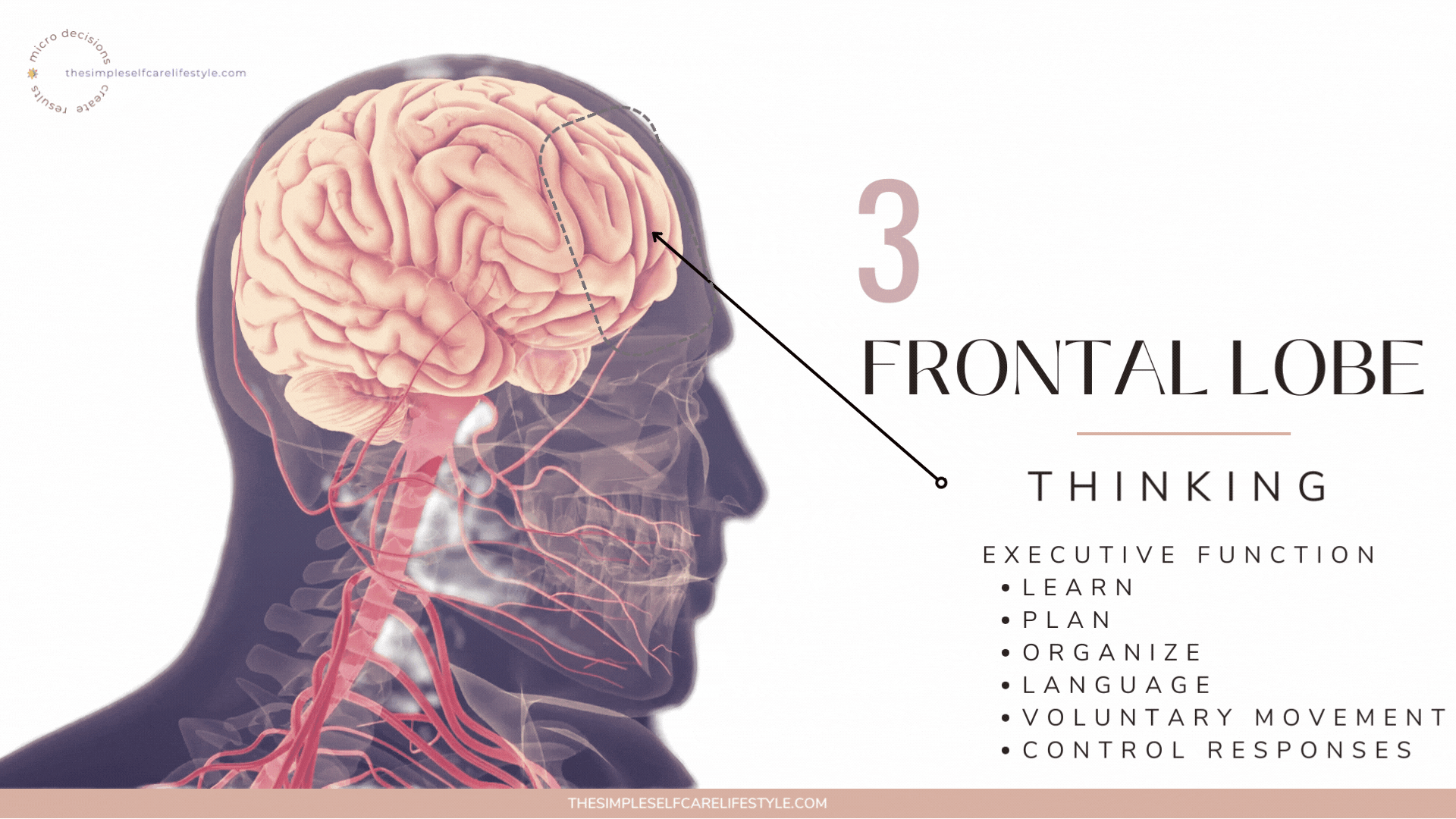
# 3 The Thinking Area
Yup, as the Emotion Area #2 and the regulator of Vital Body Functions (Brain Stem Area #1) get overexcited- simultaneously, our Frontal Lobe Area #3, the area of the brain that enables us to reason, think things through, learn, communicate…is being prompted to turn off.
Shutting Down Thinking Was a Good Set-Up Until…
Temporarily shutting down the thinking, learning, reasoning, and communicating area the-Frontal Lobe#3 was a good thing because when it shut down, it allowed the Vital Body Functions Area #1 and Emotion Area #2 of your Brain to have the extra energy it needed to more rapidly take in:
- sights,
- sounds,
- survival data, etc,…
Cutting off the reasoning processes that aren’t immediately needed to survive increases our chances of living, which is a great setup- that is, until lifestyles become full of things that trigger and mimic threats.
We’ll walk through 8 of the most common triggers in a moment.
This Hyped Up Hormone/Chemical Messaging In the 3 Areas Of The Brain is Meant to be Short-lived.
The Brain’s Emergency System:
- Brain stem (Vital Life Forces) responding to the
- Limbic Area (Emotions) sense of threat while simultaneously having the
- Frontal Lobe (Reasoning, Communication, Learning Area…) shut down.
will reverse once the threat is gone. The Emotion Area #2 perceives you are safe, and the Brain Stem Area #1 starts the messaging to your Nervous System (again via hormones/chemicals) that all is well and it’s okay to decrease your heart rate, go back to deeper breathing, etc…
This Brings You Relief

This brings your body a sense of relief, along with the downshift of our Body Systems, our Thinking, Learning, and Communications… Front Lobe Area #3 receives the signal to come back online.
All is Well…
All is well UNLESS there is repeated and frequent pressure being placed on the three areas of the brain to keep this loop going.
This brings us to the 8 Common Triggers of this cascade or loop we will cover today.
8 Common Triggers That Can Promote Anxiety.
Chronic exposure to Triggers is causing anxiety to be so common these days.
Because our Brain does NOT do a good job distinguishing between
- lifestyle stressors: school, job, relationship, social, overstimulation, lack of sleep, food excess, stimulant or intolerance, and
- a life-threatening EMERGENCY.
we keep calling on the three areas of the Brain to work as if we need to push our body into survival mode.
This is so common in today’s lifestyle that a whopping 1/3 of adults experience anxiety.
Anxiety disorders affect nearly 1 in 3 adults. (15)
What Lifestyle Stressors Can Trigger The 3 Brain Areas in a Way that Causes Anxiety?
It can be one chronic big stressor or a low-level culmination of multiple smaller body stressors. Physiological factors and psychological factors. The Anxiety experience is very individual.
The commonality is that there is a sustained, chronic use of the messaging between the 3 Brain areas.
Let’s now explore eight common triggers that can cause physiological changes that promote anxiety.
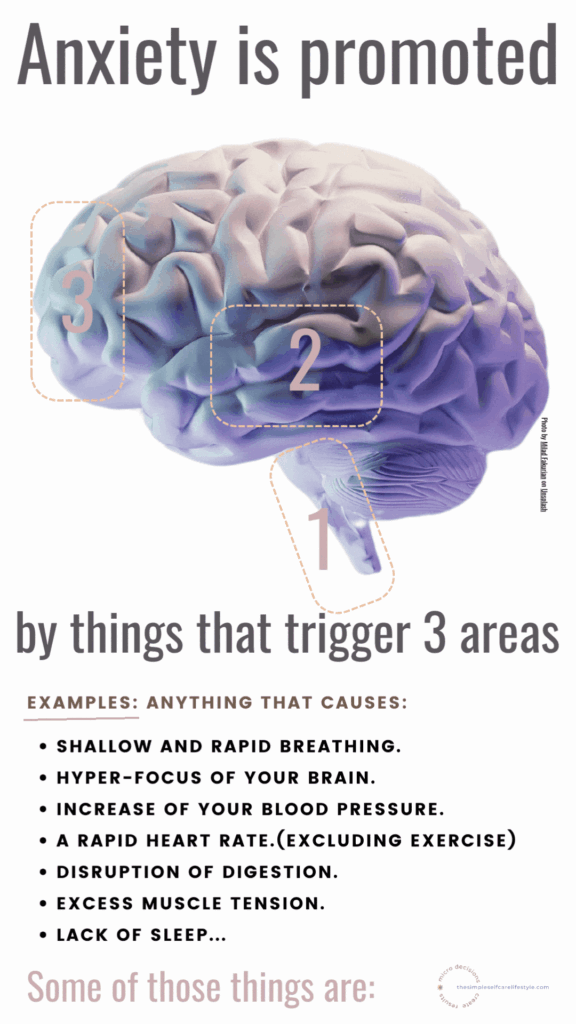
Physiological examples
When we do things that influence the Brain Stem (Area 1) to:
- Breathe shallower and more rapid.
- Have the brain be hyper-focused.
- Increase Blood pressure.
- Quicken the Heart rate.
- Disrupt Digestion.
- Keep you from sleeping well…
our body responds to these signals.
If one physiological change on the above list is happening, that’s not a cause for the body to go into alarm mode, BUT if multiple factors are influencing the Nervous System in a way that mimics more of the same physiological responses, it can cross a tipping point into causing the anxiety.
8 Common ‘Things’ that Impact Our Brain Stem
Eight common things that can get the Brain Stem (Area 1) thinking that a real threat are items that trigger:
- Breathing to be shallower and more rapid.
- The Brain to be Hyper-focused.
- An increase in Blood pressure.
- The quickening of Heart rate.
- A disruption in digestion.
- Sleeplessness…
Because our brain does not differentiate where the source of these above bodily responses come from, the other Brain areas (2 and 3) get involved.
8 Common Triggers
Triggers often accumulate and then call on the ‘Brains emergency system.’ The chronic triggering of our Brain’s emergency response system often leads to it becoming easier and easier to set off the hormonal/chemical cascades, with the end result of experiencing anxiety.
Here are eight of the most common anxiety players. What’s great is once we become aware of their role, we can take action to modify them with great success because they are in our control.
Caffeine

MSG and MfG
A list of Free Glutamate items:
Alcohol
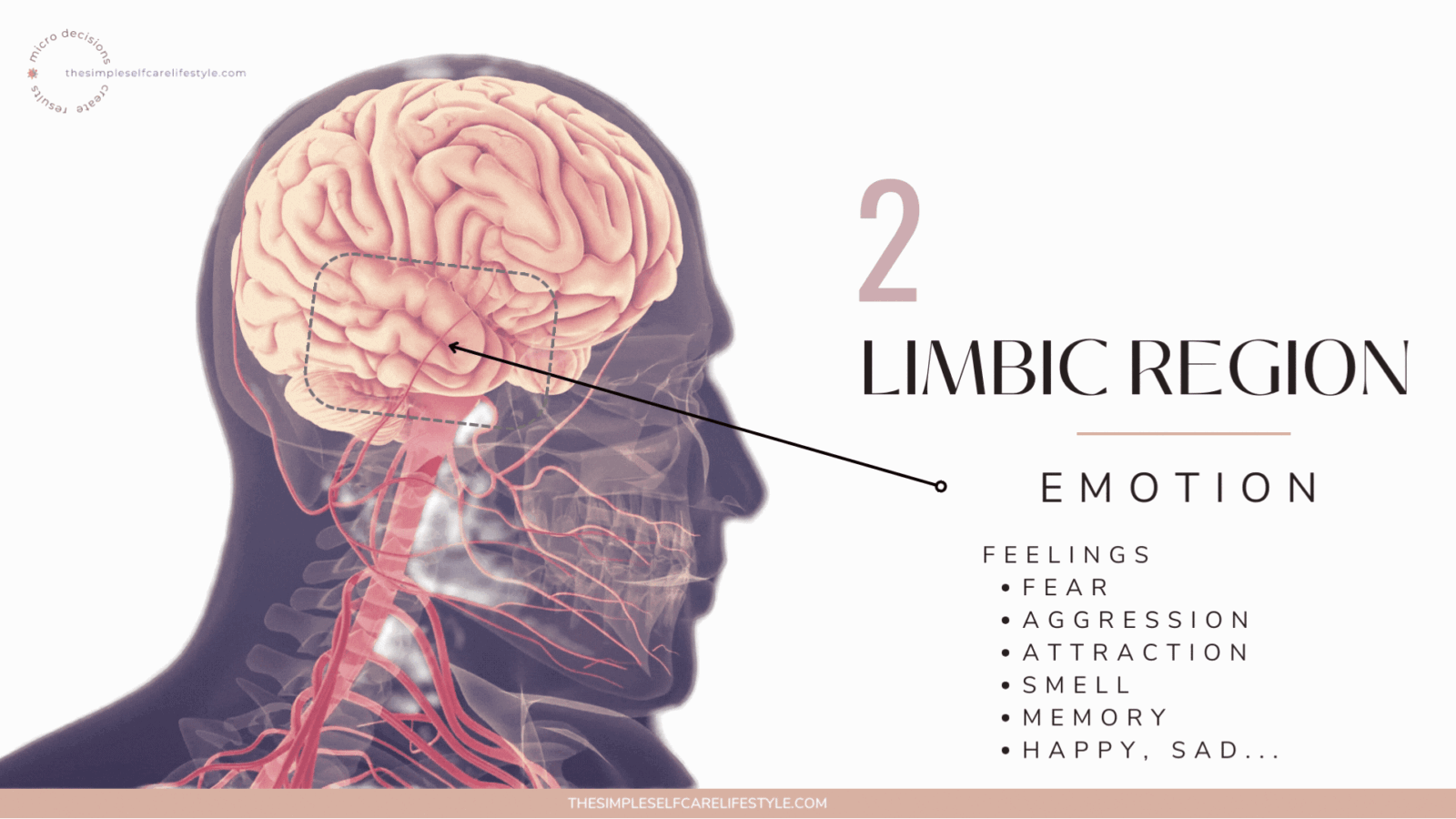
A suppressed frontal lobe (Area 3), where our Thinking, Reasoning, Organizing, and Communicating… are done, has us calling on our Emotion Area (3) to fill in the gaps.

For a small moment in time, alcohol may temporarily alleviate anxiety symptoms, but as the effects of alcohol wear off, anxiety levels rebound and potentially worsen. Alcohol also disrupts sleep.
Food Intolerances/Leaky Gut
Inflammation of the GI tract places stress on the microbiome through the release of cytokines and neurotransmitters.
Coupled with the increase in intestinal permeability, these molecules then travel systemically.
Elevated blood levels of cytokines
increase the permeability of the blood-brain barrier, enhancing the effects of rogue molecules from the permeable gut.(9),(10)
Their release influences brain function, leading to anxiety, depression, and memory loss.(10-12)
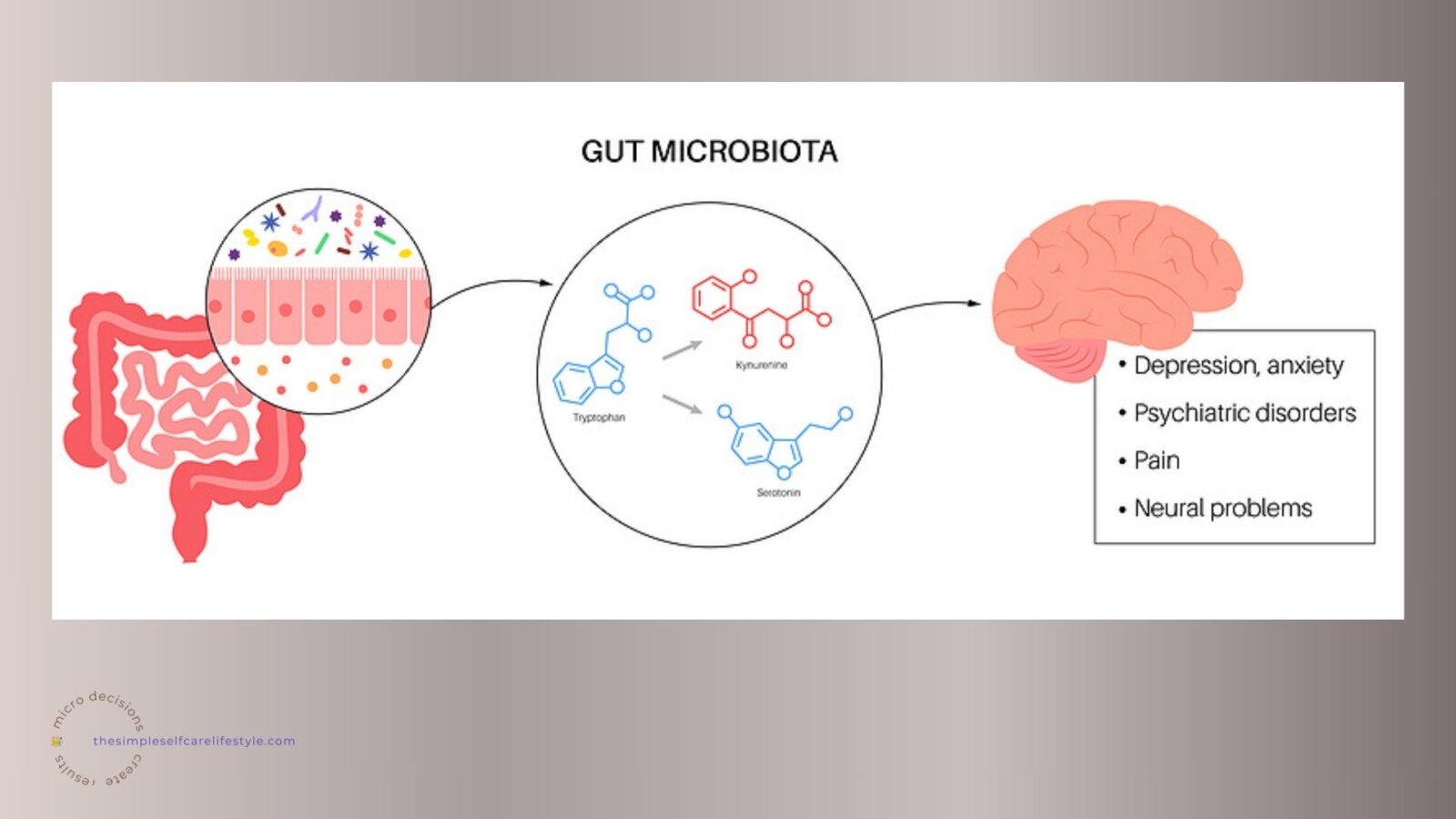
Nutrient Deficiencies or Low Dietary intake of Protein
Evidence has shown that nutrition, including dietary patterns, foods, and individual nutrients affect anxiety.
Key nutrients (eg, B vitamins, vitamin C, magnesium, and zinc) regulate stress responses via involvement in the production and metabolism of neurotransmitters, including serotonin, noradrenaline, and dopamine.
…B vitamins, vitamin C, magnesium, and zinc are involved in the conversion of α-linolenic acid to longer-chain n-3 fatty acids; n-3 fatty acids are associated with lower risk of anxiety. (18)
Protein
Research shows that deficiencies in tryptophan and other amino acids can negatively affect brain function and promote the development of depression and anxiety disorders. Conversely, this means that depression causally triggered by a protein deficiency can be overcome with proper nutrition alone.
Increased dietary tryptophan resulted in fewer depressive symptoms and less anxiety(17)
Overstimulation/Lack of Downtime/Sleep disruption
Overstimulation can cause sleep disturbance. Sleep disturbance can contribute to anxiety. When the mind is churning, the lack of downtime exhausts the nervous system and will tire your body both physically and mentally because our bodies release adrenaline and cortisol (19)(20), so you stay on high alert.
HPA Axis that is functioning suboptimally
When our HPA Axis is functioning suboptimally, we expose all our systems to a chronically high level of circulating Cortisol, which can exhaust our ability to rebalance post-stressful experiences and set us up for anxiety.
too much exposure to cortisol and other stress hormones can disrupt almost all the body’s processes. This puts you at higher risk of many health problems, including: Anxiety. (21)

Rebalancing HPA Axis
Focusing first on lowering our ‘resting’ stress level can reduce our cortisol levels and, in turn, our anxiety. Doing this 1 thing each night while you fall asleep can re-balance your HPA Axis.
Too Little Exercise
The HPA Axis system can become dysregulated when we do not move enough, leading to elevated cortisol levels, which then can contribute to increased anxiety.
Even 1 minute of exercise can make a difference!

Benefits of using 1 min Stretches
Wrapping Up
The eight common triggers I just listed are things that we can
- become aware of and
- regulate.
This helps us to decrease falsely signaling the 3 areas of the Brain that there is an existential threat.
The fewer times we call on the Fight Flight, Freeze mechanism, the less likely we will experience anxiety symptoms.
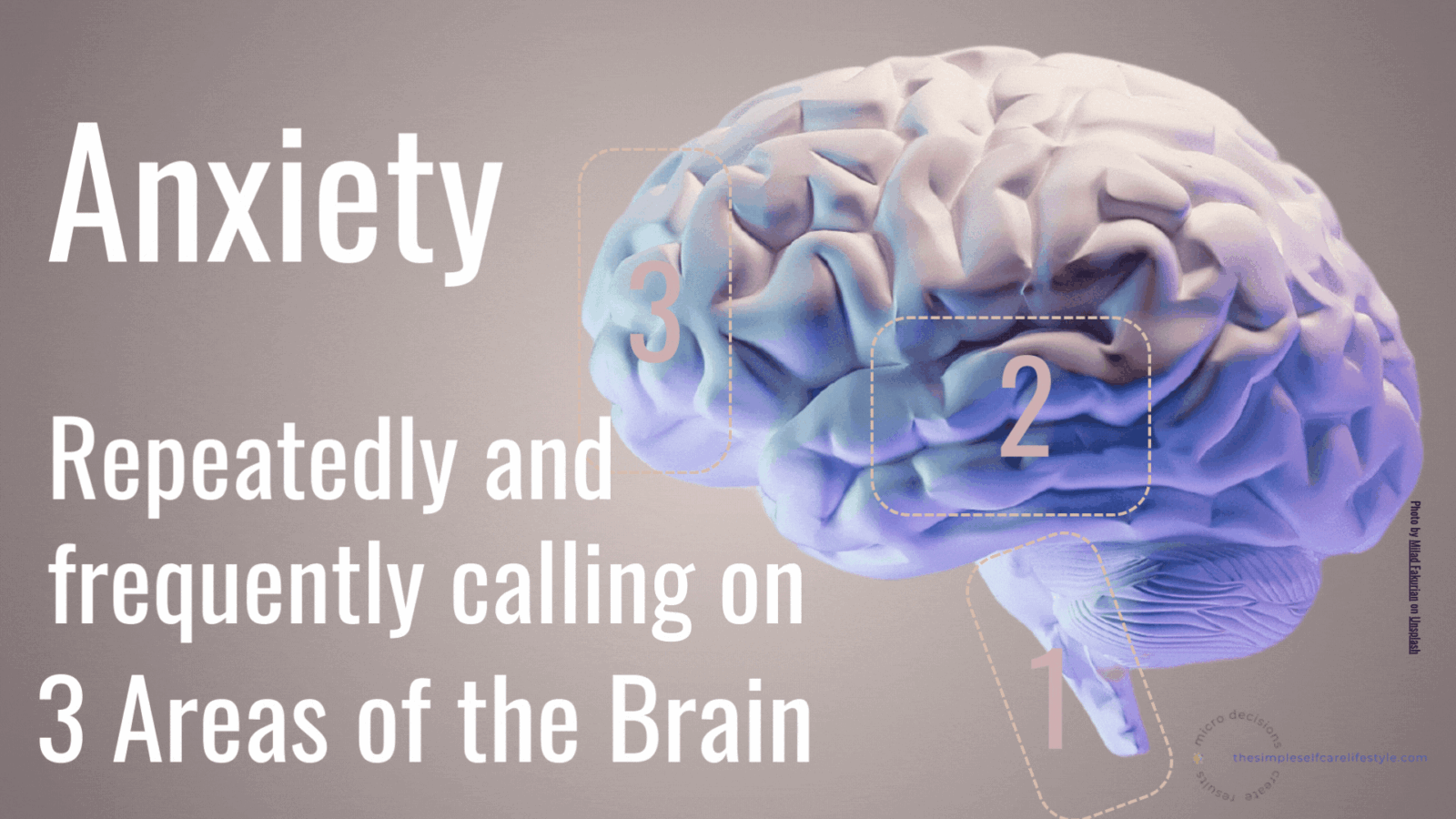
For many, trauma is a factor, and experiences can trigger anxiety.
Psychological Trauma
Difficult experiences in childhood, adolescence or adulthood are a common trigger for anxiety…
The absolute best Self Care for anxiety stemming from trauma is working closely with a healthcare professional trained in the field of mental health.
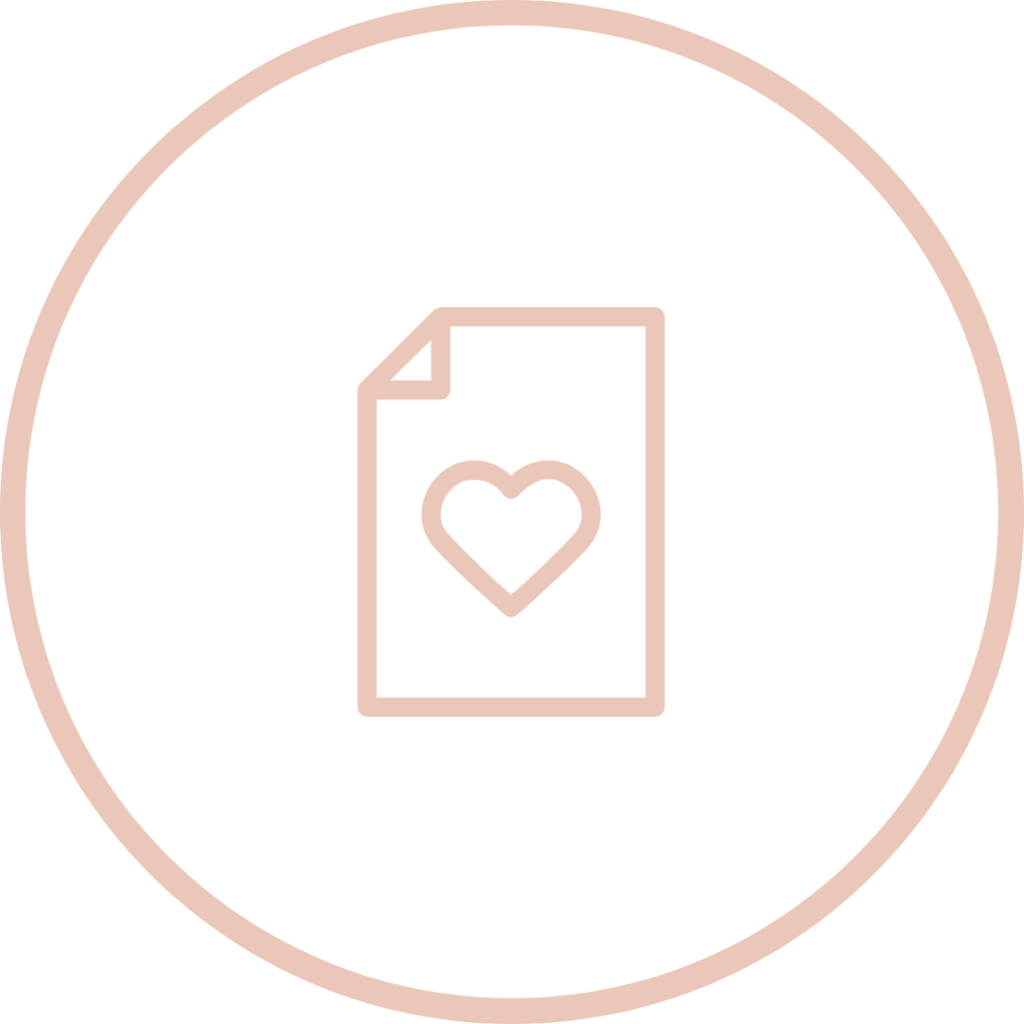
If you are experiencing anxiety symptoms, please always reach out to and consult with your healthcare practitioner for guidance, support, and a comprehensive treatment plan tailored to your specific needs.

Next Time:

Lowering Anxiety Quickly
Anxiety: How to Lower Quickly and Tips to Prevent it: The Simple Self Care Lifestyle
References for you are listed below.
THe simple self care lifestyle
Simplify
The Simple Self Care Lifestyle
References for you
1 Basinger H, Hogg JP. Neuroanatomy, Brainstem. [Updated 2023 Jul 4]. In: StatPearls Treasure Island (FL): StatPearls Publishing; 2023 Jan.
references continued
3 MediLexicon International. (n.d.). Does caffeine cause anxiety?. Medical News Today. https://www.medicalnewstoday.com/articles/anxiety-and-caffeine
4 Chen Y, Xu J, Chen Y. Regulation of Neurotransmitters by the Gut Microbiota and Effects on Cognition in Neurological Disorders. Nutrients. 2021 Jun 19;13(6):2099. doi: 10.3390/nu13062099. PMID: 34205336; PMCID: PMC8234057.
references continued
5 Muscaritoli M. The Impact of Nutrients on Mental Health and Well-Being: Insights From the Literature. Front Nutr. 2021 Mar 8;8:656290. doi: 10.3389/fnut.2021.656290. PMID: 33763446; PMCID: PMC7982519.
6 Durrani D, Idrees R, Idrees H, Ellahi A. Vitamin B6: A new approach to lowering anxiety, and depression? Ann Med Surg (Lond). 2022 Sep 15;82:104663. doi: 10.1016/j.amsu.2022.104663. PMID: 36268413; PMCID: PMC9577631.
references continued
7 Buret AG. How stress induces intestinal hypersensitivity. Am J Pathol. 2006 Jan;168(1):3-5. doi: 10.2353/ajpath.2006.050958. PMID: 16400003; PMCID: PMC1592668.
8 Ding M, Lang Y, Shu H, Shao J, Cui L. Microbiota-Gut-Brain Axis and Epilepsy: A Review on Mechanisms and Potential Therapeutics. Front Immunol. 2021 Oct 11;12:742449. doi: 10.3389/fimmu.2021.742449. PMID: 34707612; PMCID: PMC8542678.
references continued
10. Gądek-Michalska A, Tadeusz J, Rachwalska P, Bugajski J. Cytokines, prostaglandins and nitric oxide in the regulation of stress-response systems. Pharmacol Rep 2013;65:1655-62.
11. Xie G, Zhou Q, Qiu C-Z, Dai WK, Wang HP, Li YH, et al.. Ketogenic Diet Poses a Significant Effect on Imbalanced Gut Microbiota in Infants With Refractory Epilepsy. World J Gastroenterol (2017) 23(33):6164–71. doi: 10.3748/wjg.v23.i33.6164
references continued
12. Riazi K, Galic MA, Kuzmiski JB, Ho W, Sharkey KA, Pittman QJ. Microglial Activation and TNFalpha Production Mediate Altered CNS Excitability Following Peripheral Inflammation. Proc Natl Acad Sci USA (2008) 105:17151–6. doi: 10.1073/pnas.0806682105
13 Dicks LMT. Gut Bacteria and Neurotransmitters. Microorganisms. 2022 Sep 14;10(9):1838. doi: 10.3390/microorganisms10091838. PMID: 36144440; PMCID: PMC9504309.
references continued
14. Samuels A. Could Free Glutamic Acid in Processed Food be the Surprise Ingredient in Mood Disorders? Chronic Stress (Thousand Oaks). 2021 Sep 24;5:24705470211039206. doi: 10.1177/24705470211039206. PMID: 34870054; PMCID: PMC8642059.
15. Howard, L. (2023, June 3). Anxiety disorders will affect nearly 1 in 3 adults: Here’s what you need to know. news. https://health.ucdavis.edu/news/headlines/anxiety-disorders-will-affect-nearly-1-in-3-adults-heres-what-you-need-to-know/2023/05
16. Professional, C. C. medical. (n.d.). Brainstem: Overview, function & anatomy. Cleveland Clinic.
17. Lindseth G, Helland B, Caspers J. The effects of dietary tryptophan on affective disorders. Arch Psychiatr Nurs. 2015 Apr;29(2):102-7. doi: 10.1016/j.apnu.2014.11.008. Epub 2014 Dec 9. PMID: 25858202; PMCID: PMC4393508.
18. Kris-Etherton PM, Petersen KS, Hibbeln JR, Hurley D, Kolick V, Peoples S, Rodriguez N, Woodward-Lopez G. Nutrition and behavioral health disorders: depression and anxiety. Nutr Rev. 2021 Feb 11;79(3):247-260. doi: 10.1093/nutrit/nuaa025. PMID: 32447382; PMCID: PMC8453603.
19. Mayo Foundation for Medical Education and Research. (2023, August 1). Chronic stress puts your health at risk. Mayo Clinic. https://www.mayoclinic.org/healthy-lifestyle/stress-management/in-depth/stress/art-20046037
20. Professional, C. C. medical. (n.d.-b). Cortisol: What it is, function, symptoms & levels. Cleveland Clinic. https://my.clevelandclinic.org/health/articles/22187-cortisol
21. Mayo Foundation for Medical Education and Research. (2023a, August 1). Chronic stress puts your health at risk. Mayo Clinic.





